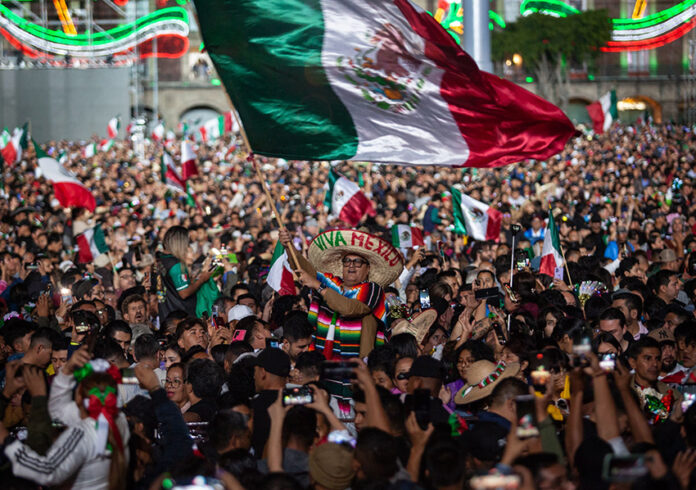The week of Sept. 15-19, 2025, Mexico witnessed milestone moments and mounting pressures that highlighted the opportunities and challenges facing the country. The week began with historic Independence Day celebrations and concluded with strengthened ties to Canada, while major infrastructure launches, economic reforms and environmental disputes illustrated the complex balancing act facing Latin America’s second-largest economy.
Didn’t have time to read every story this week? Here’s what you missed.
President Sheinbaum becomes the first woman to lead the national Cry of Independence
President Sheinbaum made history on Sept. 15 as the first female president to deliver Mexico’s Cry of Independence, using the moment to honor the nation’s female heroes. Her Grito de Independencia began with “Mexicanas, mexicanos,” giving presidence to women, and celebrating four female independence heroes: Josefa Ortiz Téllez Girón, Leona Vicario, Gertrudis Bocanegra and Manuela Molina. The ceremony, witnessed by an estimated 280,000 people in Mexico City’s Zócalo, emphasized themes of sovereignty and dignity amid ongoing tensions with the United States.
However, not all communities could celebrate freely. Threats of violence canceled Grito celebrations in several locations, highlighting persistent security challenges across the country.
The week also featured Mexico’s nationwide disaster drill on Sept. 19, marking the 40th anniversary of the devastating 1985 earthquake. The exercise, reaching over 80 million cell phone users, tested emergency response systems across all 32 federal entities, with different disaster scenarios based on regional vulnerabilities.
Infrastructure and economic development
Sheinbaum’s administration launched construction on the ambitious Querétaro-Irapuato rail line, a US $5.3 billion project designed to connect the thriving Bajío region with Mexico City. The 108.2-kilometer track represents part of Sheinbaum’s ambitious plan to build 3,000 kilometers of rail during her six-year term, potentially benefiting 2 million people and generating nearly 10,000 jobs.
The government also announced Mexico’s biggest customs reform in decades, aimed at reducing smuggling and increasing tax collection. The modernization initiative, incorporating artificial intelligence and biometric devices, is projected to generate an additional US $190.2 million in revenue by 2026. However, experts questioned whether technology alone can address deep-rooted corruption issues within the system.
The ‘super peso’ returns?
Mexico’s peso reached its strongest position against the US dollar in more than a year, following the Federal Reserve’s quarter-point interest rate cut. The currency appreciated to 18.20 per dollar, benefiting from Mexico’s higher interest rates and what analysts described as a narrative of macroeconomic stability amid nearshoring investments.
In manufacturing, production volume declined 2.7% in July despite growing export values, reflecting mixed signals in Mexico’s industrial sector. While manufacturing exports contributed over 90% of total export value at $52.3 billion, the sector shed 19,000 jobs in July alone.
Mexico-US tension and security issues
The complex relationship with the United States dominated headlines as the US named Mexico among 23 principal drug-producing countries while simultaneously praising Sheinbaum’s anti-cartel efforts. U.S. President Trump acknowledged increased cooperation, including Mexican troops at the border and CIA drone operations, but warned of “serious consequences” if drug supplies aren’t curtailed.
US names Mexico among 23 principal drug-producing countries while praising its anti-cartel crackdown
The week also saw Mexico freeze funds of a Morena lawmaker and others targeted by US sanctions related to the Sinaloa Cartel’s “Los Mayos” faction. The Financial Intelligence Unit blocked 22 accounts following the new U.S. Treasury Department designations.
Adding to migration concerns, a new survey suggested that a high ratio of recent Mexican deportees had lived in the US for more than a decade, with many experiencing family separations and unsafe detention conditions. The findings underscore the human impact of current U.S. immigration policies on communities that include Mexican emigrants.
International partnerships and trade
Canada and Mexico strengthened ties as Prime Minister Mark Carney’s visit resulted in agreements for deeper cooperation ahead of the USMCA review. The nations pledged enhanced collaboration on economic issues and security while preparing for challenging trade negotiations with the Trump administration.
Despite proposed tariff increases, Chinese automaker Great Wall Motors reaffirmed its commitment to Mexico, with officials stating the company “is here to stay” even as tariffs on Chinese car imports could rise from 20% to 50%.
Environmental and social challenges
Environmental concerns emerged prominently as residents of an Oaxaca coastal town sought relocation due to rising sea levels. The flooding in San Mateo del Mar, affecting nearly 800 families, has been linked to infrastructure projects including the Interoceanic Corridor, raising questions about development priorities versus environmental protection.
Similarly, Veracruz residents protested port expansion threatening the Gulf of Mexico’s coral reefs, demanding comprehensive environmental impact studies as ordered by Mexico’s Supreme Court.
However, in a bright spot for conservation, Mexico celebrated its first captive hatching of a Vallarta mud turtle — the smallest turtle in the world and a critically endangered species only found in the Puerto Vallarta metropolitan area.
Guadalajara Zoo celebrates its first hatching of world’s tiniest turtle
Looking forward
As Sheinbaum’s wraps up her first year in office, several key challenges and opportunities are emerging for the country. Major infrastructure projects like the passenger rail system are set to test the administration’s execution capabilities and fiscal management. The upcoming USMCA review presents both risks and opportunities for Mexico’s trade relationships, particularly with an increasingly protectionist United States. Meanwhile, ongoing security challenges and the planned customs reform highlight Mexico’s persistent struggle against organized crime and corruption.
Sheinbaum’s presidency is already demonstrating a distinct approach to governance, from her historic Independence Day address to her ambitious infrastructure agenda. However, the true test will be whether her administration can deliver on its promises while navigating an increasingly complex geopolitical landscape. With the peso showing strength, major construction projects underway and new trade partnerships forming, Mexico appears positioned for growth — yet persistent challenges around security, environmental protection, and U.S. relations will require careful diplomatic and policy management in the months ahead.
Mexico News Daily
This story contains summaries of original Mexico News Daily articles. The summaries were generated by Claude, then revised and fact-checked by a Mexico News Daily staff editor.
